The Social Document: Dorothea Lange’s ‘Migrant Mother’
Dorothea Lange’s Migrant Mother is widely recognized as the most popular social documentary photograph of all time. During the course of her 40-year career, Lange’s style as a photographer proposed that social documentary photography is a humanist art form. Her images of Americans struggling during the Depression, as well as of Japanese families interred at Manzanar in World War II, are etched in the popular imagination as pictorial messages of strength and hope.
Family Background
Born Dorothea Nutzhorn, in Hoboken, New Jersey, Dorothea Lange was the eldest child in a first-generation German-American family. Her father practiced law and her mother was an opera singer. Lange’s early life was marked by harsh emotional and physical challenges: At the age of seven, she contracted polio, which resulted in permanent damage to her right leg and foot. She walked with a pronounced limp that, over time, affected her overall mobility. Years later she explained “It [polio] formed me, guided me, instructed me, helped me, and humiliated me. All those things at once.” Lange’s parents divorced, and her father disappeared. As a teenager she took her mother’s surname and announced her desire to become a photographer.
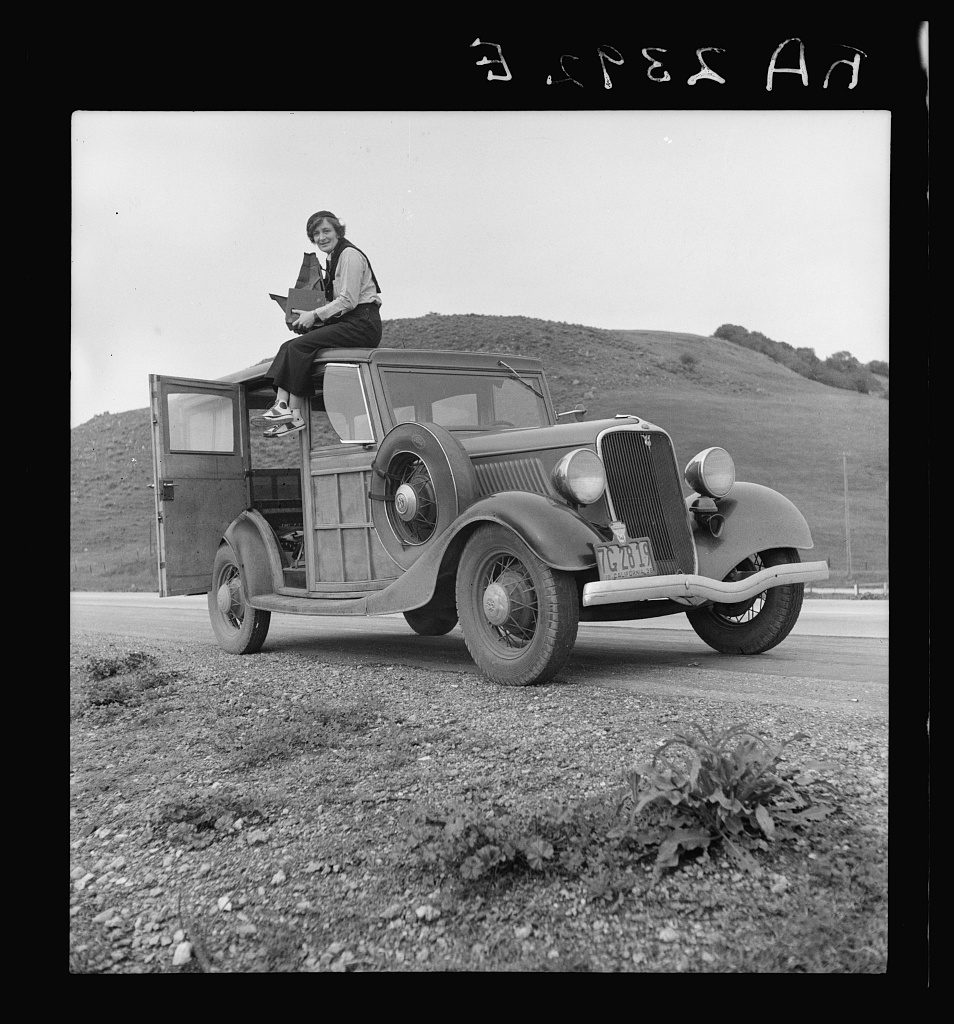
Lange attended an immigrant-dominated public school in New York’s Lower East Side and explored the city’s diverse cultural life. She found an after-school job in the Fifth Avenue studio of Arnold Genthe, a successful portrait photographer and artist, who had emigrated to New York from Berlin. Working with Genthe, she learned how to artfully compose subjects, properly light them, process negatives in a wet darkroom and craft fine photographic prints. Afterward, she studied photography formally with Clarence H. White, an educator who had been associated with Alfred Stieglitz’s artistic circle, the Photo-Secession, at Teachers College, Columbia University.
Influences of the Bay Area
In 1918 Lange left the east coast and found work as a photo finisher in the San Francisco Bay Area. She befriended Imogen Cunningham, an accomplished photographer known for artistic, soft-focus Pictorialist works. Cunningham was married to Roi Partridge, an artist and printmaker, and had relocated to Oakland from Seattle, where she had worked for Edward S. Curtis. Cunningham introduced Lange to local artists, among them Maynard Dixon, whom Lange married in 1920. Five years later she had her first child, Daniel, one of two sons. Lange opened her own portrait studio, which flourished as she photographed the Bay Area’s elite families, earning a reputation for artistically rendered portraits.
Related Reading: California Modernism: Photography from Group f/64
The Depression and New Visions
With the Great Depression and the collapse of America’s social fabric and economy, Lange’s business faltered. She shifted focus, taking herself out of the studio and into the street. Her studies of demonstrations, protests, and unemployed workers seeking assistance in the early 1930s captured the attention of Roy Stryker, director of the Resettlement Administration. The RA, a New Deal agency that was later renamed the Farm Security Administration, was tasked with assisting the rural poor.
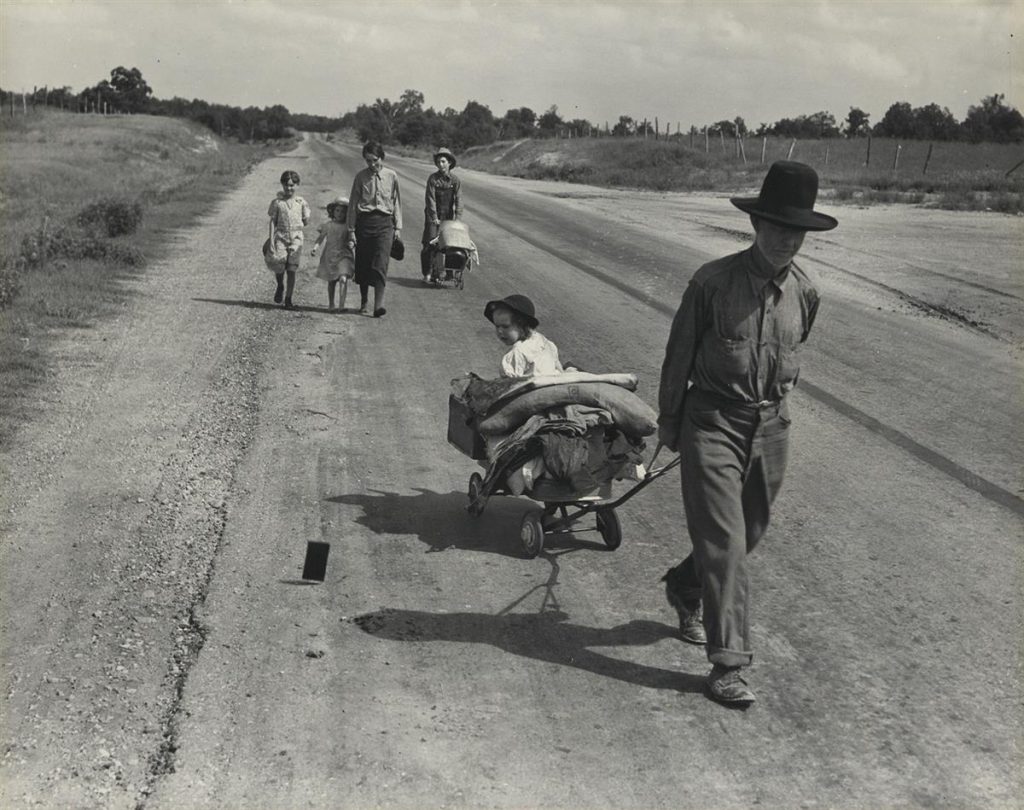
Roy Stryker, a Professor of Economics at Columbia University, who had used Lewis Hine’s images in a textbook, recognized the potential of photography to foster social change. From D.C. he hired a group of talented individuals: Lange, Walker Evans, Arthur Rothstein, Ben Shahn and Marion Post Wolcott, to travel throughout the country and create stories that depicted the disenfranchised and impoverished as Americans who deserved assistance. Many of these professional photographers employed medium- and large-format cameras, like Lange’s 4×5-inch Graflex. Unlike today’s point-and-shoot automatic cameras, the operation of these devices was more deliberate: each shot required loading a single sheet of film into the camera.
Related Reading: Lewis Hine & The Invention of the Photo Story
A Rainy Day in Nipomo, California
In February 1936 Lange’s assignment required a month-long road trip in central California. She finished her work in Nipomo, a remote, rural region seven hours from her home in Oakland. Her plan was to drive home, see her children and send the exposed film to Roy Stryker. It was a cold morning. She began her long drive and glimpsed, out of the corner of her eye, a hand-lettered sign that read PEA-PICKERS CAMP, with an arrow. She continued to drive, in the rain, while her inner voice persisted. Decades later, Lange recounted the experience:
I was on my way and barely saw a crude sign with a pointing arrow which flashed by at the side of the road, saying PEA-PICKERS CAMP. But out of the corner of my eye I did see it. I didn’t want to stop and didn’t. I didn’t want to remember that I had seen it, so I drove on and ignored the summons. Then, accompanied by the rhythmic hum of the windshield wipers, arose an inner argument:
Dorothea Lange in an 1960 interview with Popular Photography
Dorothea, how about that camp back there? What is the situation back there?
Are you going back?
Nobody could ask this of you, now could they?
To turn back certainly is not necessary. Haven’t you plenty of negatives already on this subject? Isn’t this just one more if the same? Besides, if you take a camera out in the rain, you’re just asking for trouble. Now be reasonable, etc. etc. etc.
Having well convinced myself for 20 miles that I could continue on, I did the opposite. Almost without realizing what I was doing I made a U-turn on the empty highway. I went back those 20 miles and turned off the highway at that sign, PEA-PICKERS CAMP.
Creating Migrant Mother
Instinct. Intuition. Intention. Lange returned to Nipomo, where more than 2,500 destitute migrant workers and their families had camped. She set her gaze on a mother and children in a lean-to tent, exposed to the elements. The subject told Lange she was 32 years old and had five children.
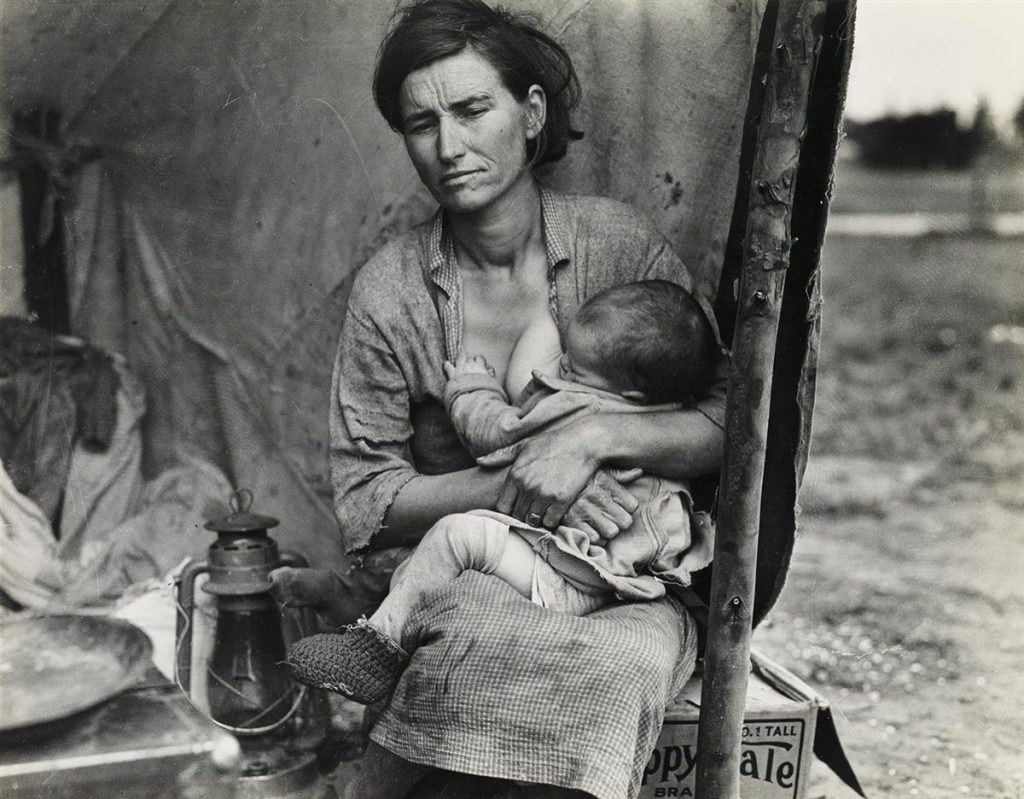
The first shot was taken from a distance with the mother huddled at the far right, cradling an infant, and her children dispersed slightly further away, both in and out of the tent. Lange slowly approached the woman but did not ask her name or details of her personal history. A later negative had the children rearranged in the frame, standing closer to their mother but gazing at the camera, fully aware of the photographer’s uninvited presence as she drew closer. Lange continued to move in, finding other angles. In another composition, she placed the mother and infant in a corner, a younger child at her mother’s left shoulder, and an empty plate on top of their trunk. A follow-up scene reveals breastfeeding. Unsurprisingly, Lange’s final shot is her closest: the mother is centrally positioned, gazing into the distance, while her children, their backs to the camera, lean in on either side. This image found immediate currency in the picture press and catapulted Lange to national attention. Lange shot a total of seven negatives in about ten minutes.
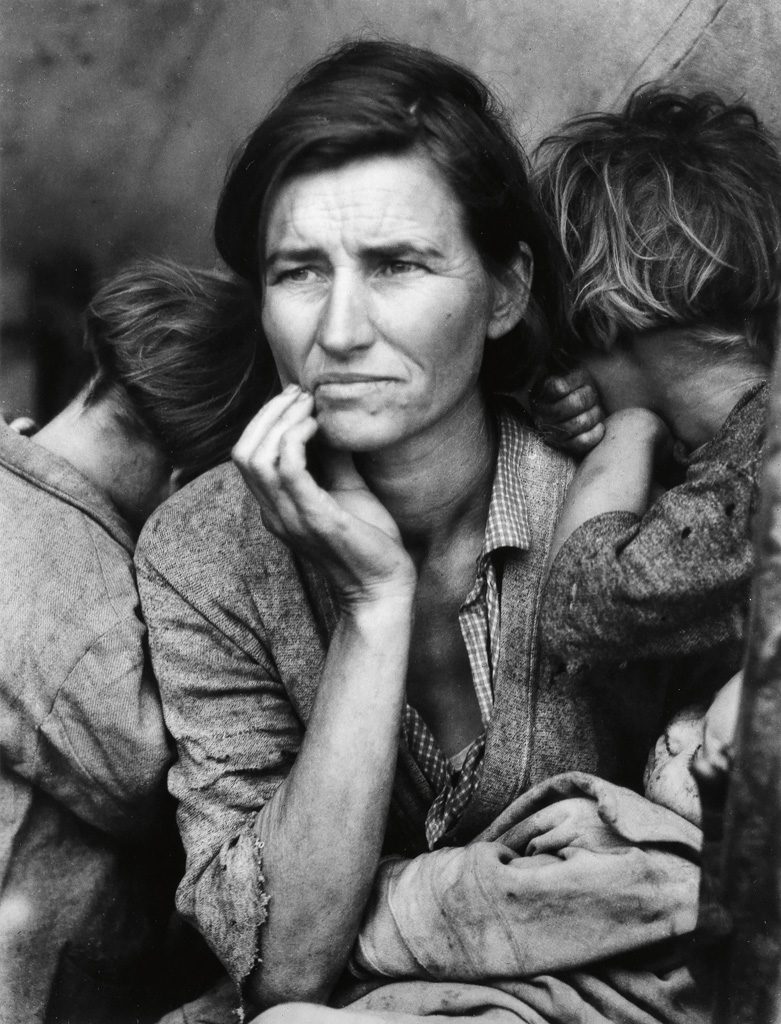
After returning to Oakland, Lange contacted local newspapers about the large camps of destitute migrant laborers. Migrant Mother quickly became a symbol of the Great Depression, galvanizing the federal government to distribute relief funds to indigent workers. But since Lange had been in a hurry to get home, and did not supply her own descriptive captions, picture editors provided their own. Swann’s Photographs & Photobooks department has cataloged the image as Migrant Mother. However, alternate titles have read “Human Erosion in California,” “Pea Pickers Camp,” “Destitute Peapickers,” or “A peapickers family.” To further confuse matters, captions that appeared in newspapers included inaccurate information, such as, “These people had just sold their tent in order to buy food.”
It wasn’t until more than forty years later that the family’s actual story came to light. Lange’s subject, Florence Owens Thompson, was identified, and her Native-American heritage was revealed, and the grim realities of the family’s circumstances correctly noted. In 1979, Mrs. Thompson and her family were interviewed on national television. In a respectful—if misguided—characterization, the interviewer referred to Thompson as the “Mona Lisa of the Dust Bowl.” Thompson’s adult children were asked, on the air, about their mother’s influence and one simply replied, “She gave us all a sense of worth that nobody owes us anything.”
The Original and the Copy
Explanations associated with vintage and modern prints are inadequate in defining Lange’s more complex market. Lange’s single original negative of Migrant Mother, which was created in 1936, contains a tiny spider-like crack in Thompson’s forearm, near the elbow. (The cause is unknown.) The 5×4-inch negative has been stored at the Library of Congress, Prints & Photographs Division, along with thousands of other FSA negatives, chromes and prints by other photographers, since the 1940s. Prints from this negative are considered the true, first iteration of the portrait—in other words, the vintage print. On the rare occasions when a vintage print comes to market, it is highly sought after.
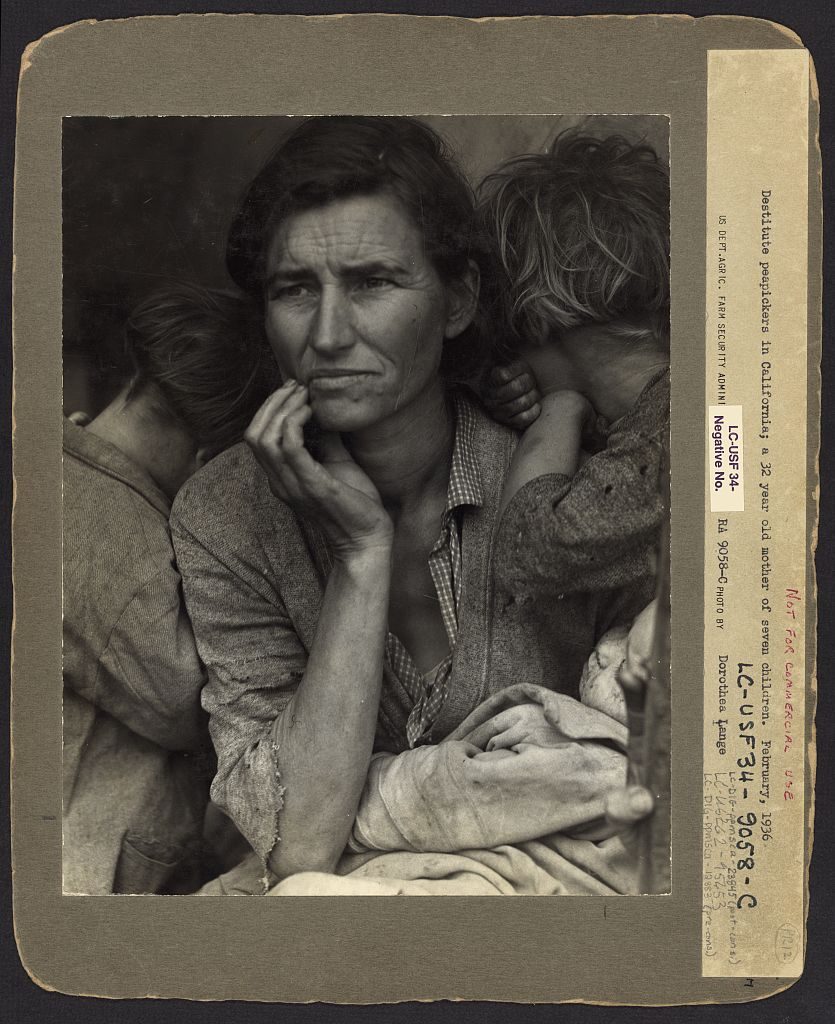
The physical characteristics of the object are essentially those of a press print. The photograph is on single-weight paper stock, measuring 10×8-inches, with a glossy or ferrotyped surface; a typewritten caption (supplied by the FSA) appeared on print verso. Each print was undoubtedly generated by a darkroom technician, in other words, Lange had no hand in its creation since, like all FSA photographers, she had relinquished her negatives to the agency.
But as a devotee of the art of photography and fine photographic printmaking, Lange was not satisfied with this arrangement. In 1939, long before the advent of Photoshop, she had an assistant retouch the negative to remove a ghost-like thumb from the lower right corner of the image, which she characterized as a “defect.” This iteration is a copy negative, but the later date rarely appears in catalogue entries. Lange’s prints from this second negative measured as large as 20×16 inches. Her photographs were printed on lustrous matte surface papers, flush-mounted and signed or inscribed on verso. Examples of these later (or modern) prints, which Lange gifted to friends and colleagues, generally realize between $100,000 to $150,000 at auction, depending on the overall size of the photograph, whether she signed the verso or affixed a studio hand stamp, its provenance and condition.
The Growing Market for Photography
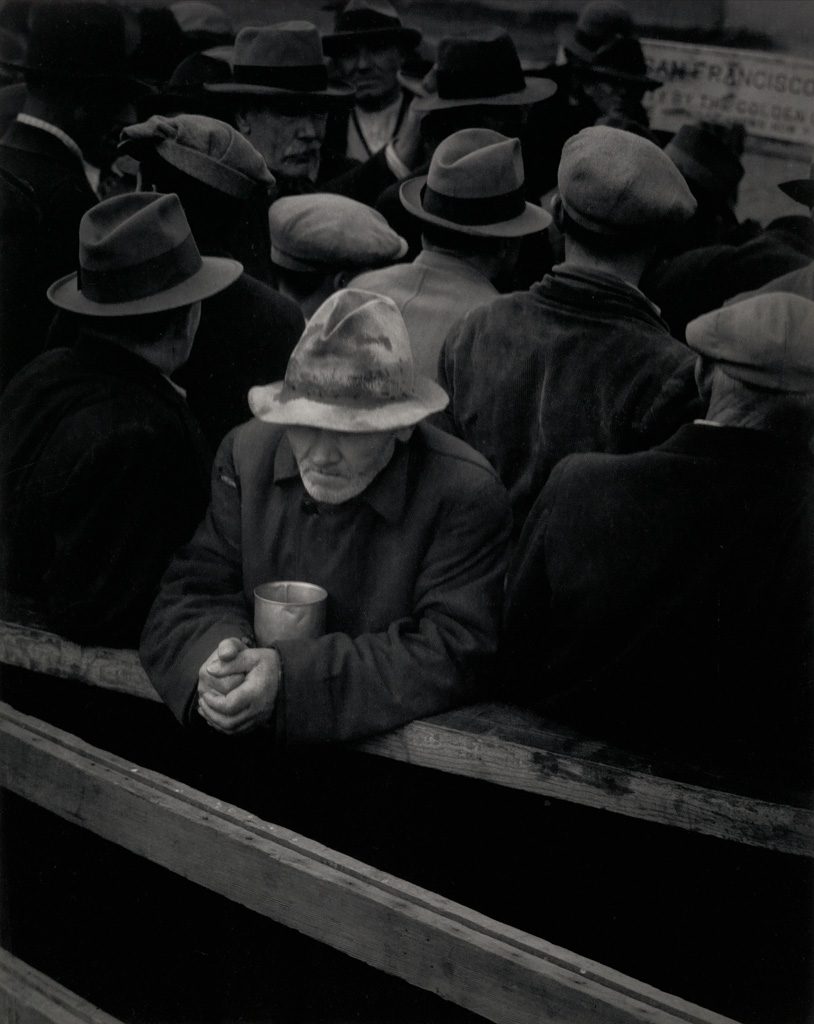
In 1964-65 Lange was preparing for a major retrospective at the Museum of Modern Art, curated by John Szarkowski. By this time she relied on the master Bay Area printer Irwin Welcher, and General Graphics, a local lab, to produce all of her photographic prints. A 14×11-inch print of White Angel Breadline (a beautiful print that was made for the exhibition but apparently kept by her), affixed to a 16×13-inch mount, realized $30,000 at Swann in October of 2016. When prints from this period come to market, they’re unsigned but are always conveyed with provenance, or a prior association of ownership. In 2015 a 14×11 inch print of Migrant Mother that was produced in the 1970s, but also had an important provenance, realized $20,000 at Swann.
During the tumultuous era of the late 1960s through the early 1970s images increasingly dominated popular culture, and a bona fide commercial marketplace for fine art photographs emerged. Galleries dedicated to photography opened in New York City and San Francisco, and auctions were conducted featuring photobooks, albums and vintage prints. Museums, libraries and public institutions recognized the public’s strong interest in pictures. The Library of Congress sold copies of Migrant Mother and other key FSA images on demand. Prints were made on a variety of fiber papers, in small (10×8’’) and medium (14×11’’) formats, many identified with a Library of Congress hand stamp as savvy young photographers, art students, and collectors all embraced photography as a tool for social change. In Swann’s February 2020 sale, a 10×8-inch print with the Library of Congress hand stamp on verso realized $6,500.
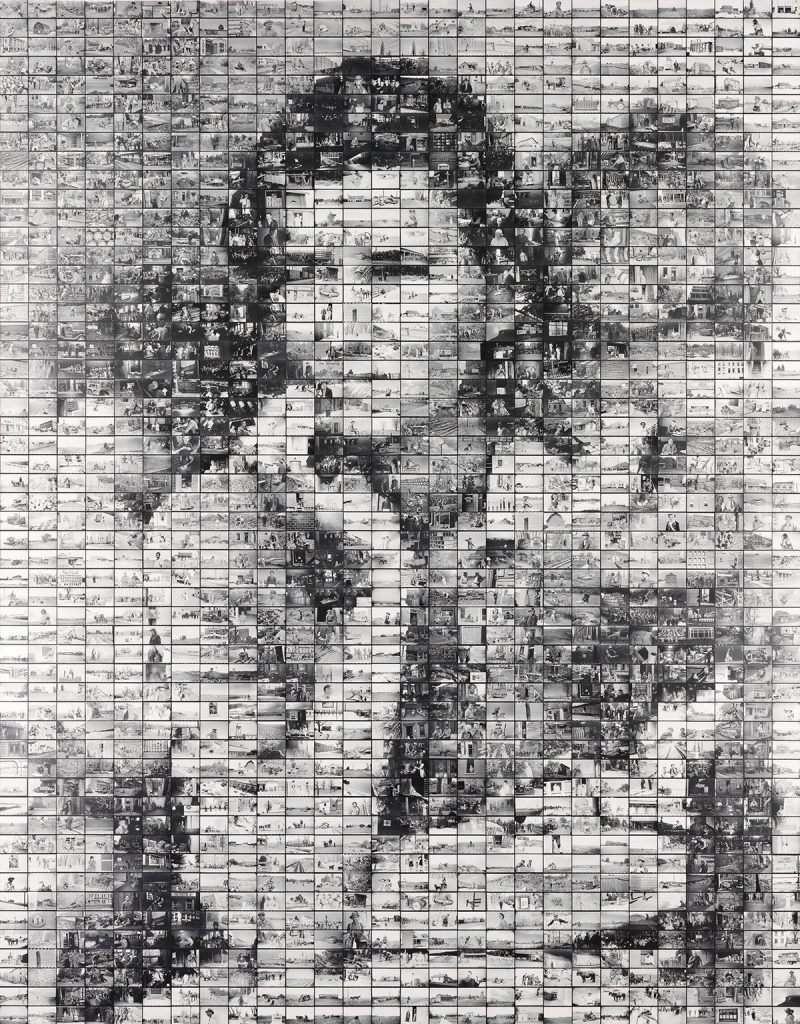
Images of Migrant Mother adorn countless consumer products, from puzzles to postage stamps. Digital photography has resulted in innovative forms of interpretation. A mural-size photomosaic of Migrant Mother, composed of hundreds of tiny FSA images, was produced by Robert Silver, an MIT student who invented the process. The large aluminum-backed photograph realized $14,375 on October 18, 2018, ushering in a new generation of collectors.
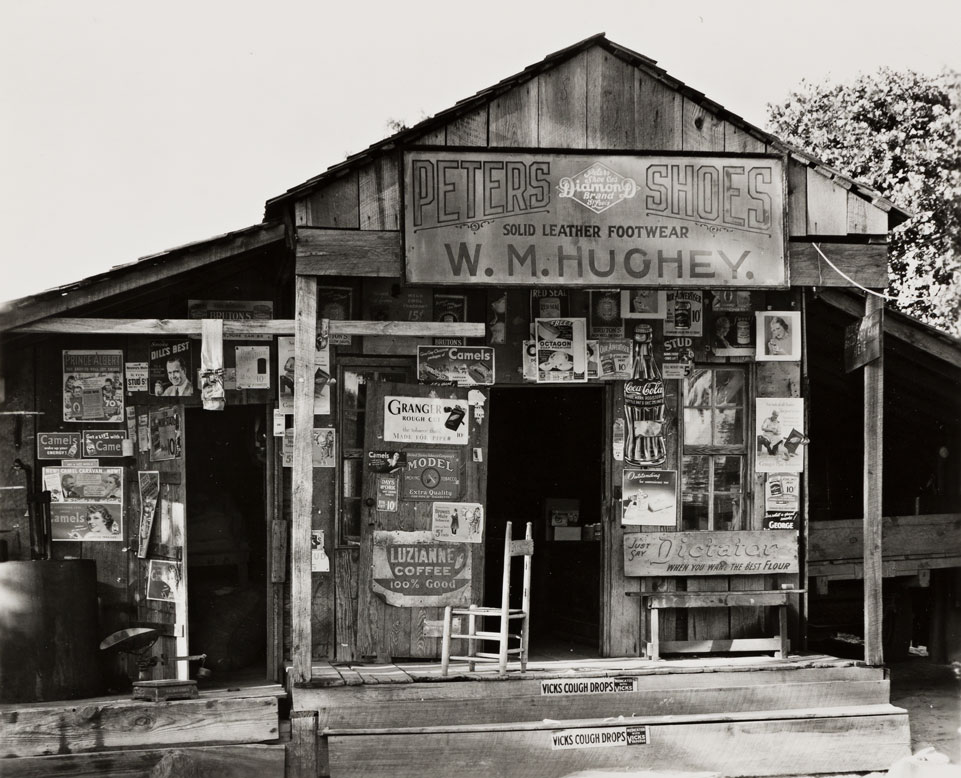
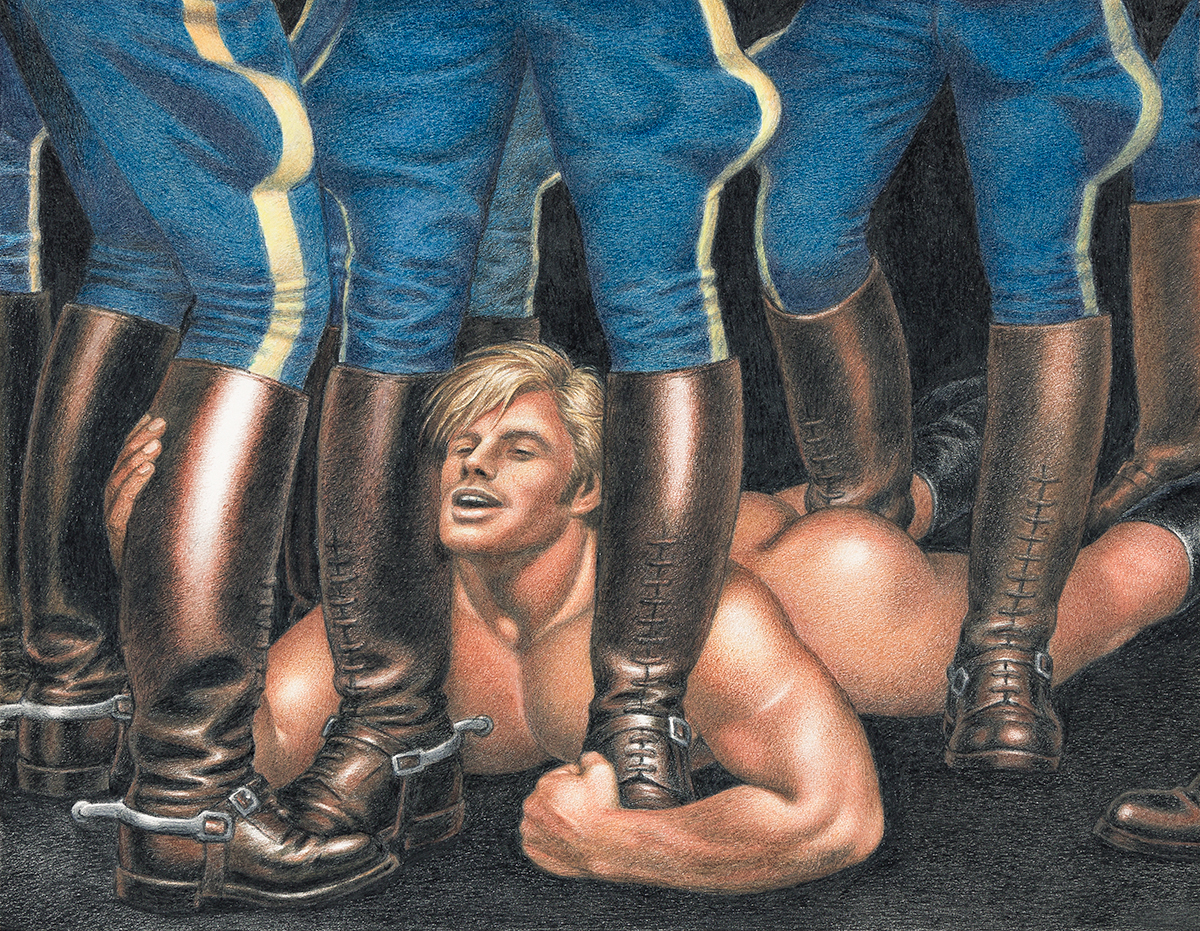
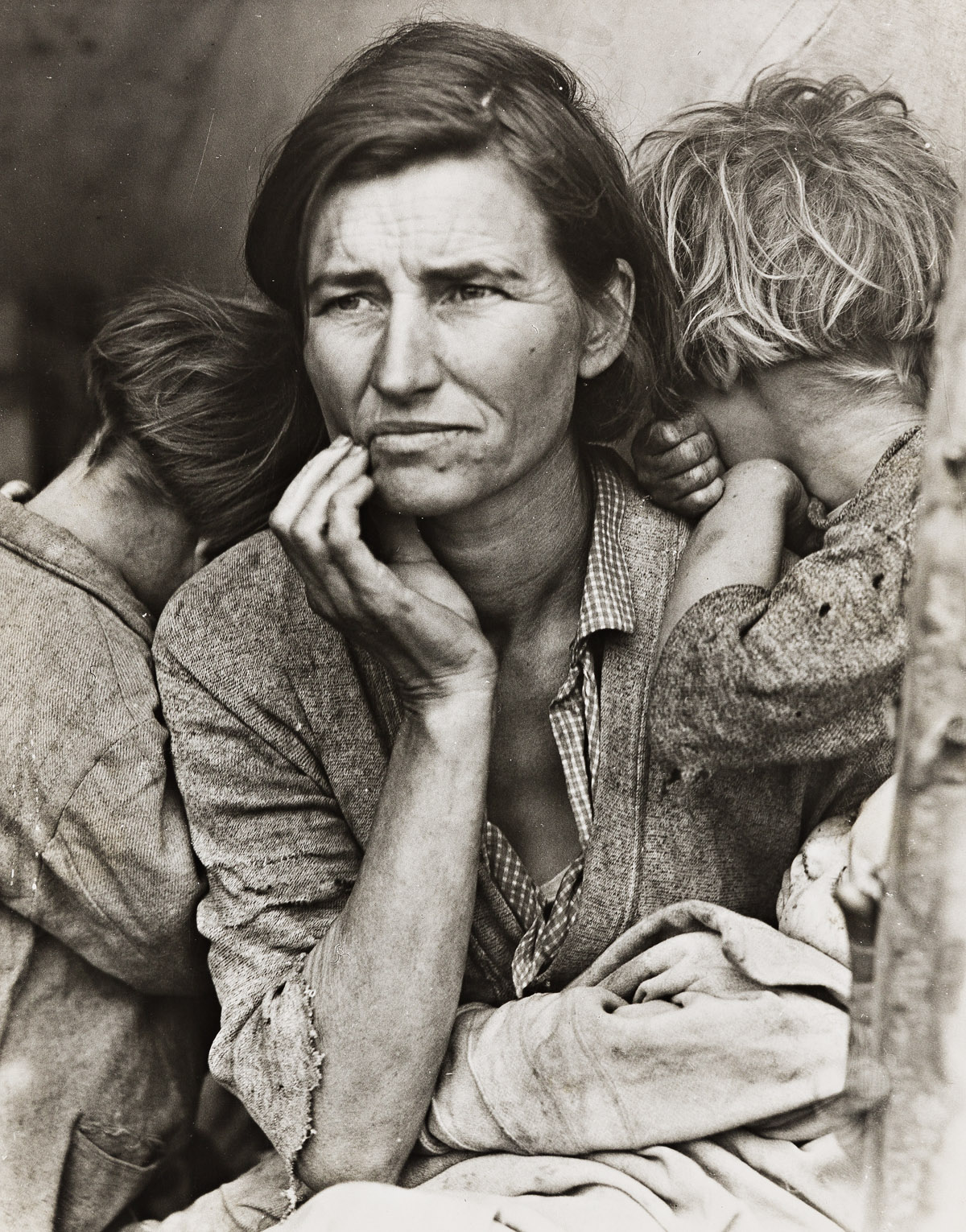














![Grace Meschery-McCormack shares about two copies of Fernando de Rojas’s ‘La Célestine,’ including a limited edition copy illustrated by Pablo Picasso.
At auction April 22. Learn more about the works at the link in our bio.
#Rarebooks #rarebookdealer #antiquarianbooks #auctions
_______________________________________
Music Credit:
Schubert - Piano Quintet in A major ‘The Trout’, D. 667 - IV. Andantino – Allegretto
Music provided by Classical Music Copyright Free on Youtube [https://tinyurl.com/visit-cmcf]
Watch: • Schubert - Piano Quintet in A major ‘...]](https://scontent-iad3-1.cdninstagram.com/v/t51.75761-15/491443494_18499096345036585_5935932878956098058_n.jpg?stp=dst-jpg_e35_tt6&_nc_cat=107&ccb=7-5&_nc_sid=18de74&_nc_ohc=QlZg0o3Vx4oQ7kNvwHlPDYS&_nc_oc=Admkx5CH3-5gNl9kFtE07uGBWzC1TrU8LutoXTk30m77fiWC0m2_oIjIUSQBbJE8mA8&_nc_zt=23&_nc_ht=scontent-iad3-1.cdninstagram.com&edm=AM6HXa8EAAAA&_nc_gid=Pe1umN91MEXpkwcZIAoyzA&oh=00_AfL0aLte8jNzcTguOVsdcdqJNkw1tTNFwy_v2TCIwQ11Pw&oe=6828BE91)
